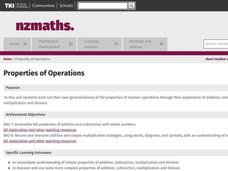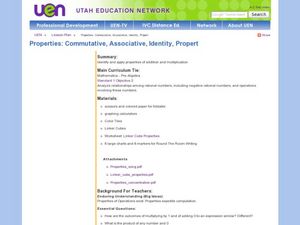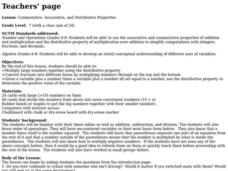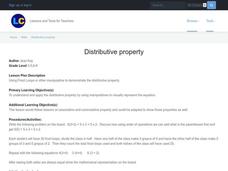New Zealand Ministry of Education
Properties of Operations
Learners consolidate and extend understanding of simple properties of the four arithmetic operations. They use these properties as an aid to easy calculation. They discover and use some more complex properties of addition, subtraction,...
California Education Partners
Theater Field Trip
Here's an assessment task that's better than watching a show. Young mathematicians solve word problems involving multiplication and division with equal groups. They must find the total number of attendees on a trip to a theater based on...
EngageNY
The Multiplication of Polynomials
If you can multiply multi-digit integers, you can multiply polynomials. Learners use an area model to compare multiplying numbers to multiplying polynomials. They progress to using the distributive property.
EngageNY
Multiplication of Numbers in Exponential Form
Develop a solid understanding of multiplication and division properties of exponents. Individuals expand exponential terms to discover the patterns and create the properties in the second installment in a series of 15. The activity...
West Contra Costa Unified School District
Simplify Expressions and Solve Equations Using Two-Column Proofs
Increase understanding of the algebraic properties and their importance. Scholars justify their steps as they simplify expressions and solve equations. They formalize their work as two-column proof.
EngageNY
Replacing Letters with Numbers II
Teach about properties properly. Individuals investigate the commutative and identity properties for both addition and multiplication. They see that the properties hold true for all values by using substitution to test out several examples.
EngageNY
Solving a Linear Equation
Solving an equation is the art of creating simpler equivalent equations using properties of equality. Here, classes see that solving an equation is not always as easy as guessing. The lesson presents linear equations that scholars must...
Science Friday
Mineral Madness
Science does not need to be as hard as a rock. Pupils test 10 different minerals to determine their properties. The learners observe luster, streak, hardness, and fluorescence for each specimen. Afterwards, they compare and contrast the...
EngageNY
Numbers Raised to the Zeroth Power
What in the world is the zeroth power? Examine the patterns of exponents as they apply to the zeroth power. Scholars apply the zero property to simple exponential expressions in this fourth lesson in a series of 15. The examples include...
Curated OER
Division Problems with 0 and 1
Students explore beginning division. In this division number properties lesson, students solve simple division story problems using cookies. Students create models that represent the identity and zero properties, then write explanations...
Curated OER
Properties: Commutative, Associative, and Identity
Students explore the concept of addition and multiplication properties. In this addition and multiplication properties lesson, students create a foldable with the properties commutative, associative, identity, and distributive written...
Curated OER
Commutative, Associative, and Distributive Properties
Students explore the concept of the associative, commutative, and distributive properties. In the associative, commutative, and distributive properties instructional activity, students discuss real world examples of each property....
Helping with Math
Division: Four Digit by One Digit
Lengthen learners' long division skills with this single-page handout. They must use problem solving skills to find the quotient when a four-digit number is divided by one digit. This is a nice assignment for early in the process of...
Curated OER
Properties
Seventh graders explore the concept of properties. In this properties lesson, 7th graders discuss the various math properties including the commutative, associative, distributive, multiplication properties and so on. Students create...
Pennsylvania Department of Education
Associative Properties
Young scholars investigate the associative property of addition. In this associative property of addition activity, students work in pairs and build addition problems with six blocks. They sit on either side of a desk so that they can...
Curated OER
Distributive Property
Students explore the distributive property. In this algebra lesson plan, students are given Fruit Loops or other manipulatives and the class is divided in half. Each half of the class completes part of the equation to show that both...
Curated OER
Division: Dividends to 81
In this division facts practice learning exercise, students sharpen their math skills as they solve 30 problems that require them to divide 2-digit numbers by 1-digit numbers.
Helping with Math
Decimals: Dividing -3
In this decimal division worksheet, students divide the decimal equations for 18 problems. Students improve their division skills by completing the online division activity.
Curated OER
Division: Three Digit by Two Digit
In this division problem, students solve for the quotients in 24 three digit by two digit division problems. They use the long division method to find each quotient.
Curated OER
Properties of Equality
In this properties of equality worksheet, students solve 5 problems in which an equation is presented. Students answer the question pertaining to the equation and explain their reasoning. There is an instruction box with equality rules...
Curated OER
Exponents and Their Properties - Multiplying and Dividing Monomials
In this multiplying and dividing monomials worksheet, students solve 105 short answer problems. Students multiply and divide monomials. Students simplify their answers using exponent rules such as product to a power or quotient to a power.
Curated OER
Properties of Multiplication
Fifth graders examine the process of multiplication and the relationship between addition and multiplication. They observe the teacher model a variety of problems on the board, and identify properties of multiplication. Students...
Curated OER
Multiplying Polynomials
Help learners study polynomials. They will review how to multiply polynomials either by using the FOIL method if they are multiplying a binomial by another binomial, or by using the distributive property.
World Wildlife Fund
Take 6
Investigate the various properties of the number six with this elementary math lesson. From simple addition, subtraction, multiplication, and division problems to the creation of hexagonal tessellations, this lesson covers all aspects of...























